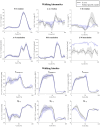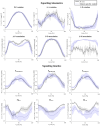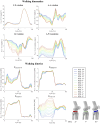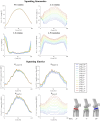Posterior tibial slope influences joint mechanics and soft tissue loading after total knee arthroplasty
- PMID: 38686117
- PMCID: PMC11056792
- DOI: 10.3389/fbioe.2024.1352794
Posterior tibial slope influences joint mechanics and soft tissue loading after total knee arthroplasty
Abstract
As a solution to restore knee function and reduce pain, the demand for Total Knee Arthroplasty (TKA) has dramatically increased in recent decades. The high rates of dissatisfaction and revision makes it crucially important to understand the relationships between surgical factors and post-surgery knee performance. Tibial implant alignment in the sagittal plane (i.e., posterior tibia slope, PTS) is thought to play a key role in quadriceps muscle forces and contact conditions of the joint, but the underlying mechanisms and potential consequences are poorly understood. To address this biomechanical challenge, we developed a subject-specific musculoskeletal model based on the bone anatomy and precise implantation data provided within the CAMS-Knee datasets. Using the novel COMAK algorithm that concurrently optimizes joint kinematics, together with contact mechanics, and muscle and ligament forces, enabled highly accurate estimations of the knee joint biomechanics (RMSE <0.16 BW of joint contact force) throughout level walking and squatting. Once confirmed for accuracy, this baseline modelling framework was then used to systematically explore the influence of PTS on knee joint biomechanics. Our results indicate that PTS can greatly influence tibio-femoral translations (mainly in the anterior-posterior direction), while also suggesting an elevated risk of patellar mal-tracking and instability. Importantly, however, an increased PTS was found to reduce the maximum tibio-femoral contact force and improve efficiency of the quadriceps muscles, while also reducing the patellofemoral contact force (by approximately 1.5% for each additional degree of PTS during walking). This study presents valuable findings regarding the impact of PTS variations on the biomechanics of the TKA joint and thereby provides potential guidance for surgically optimizing implant alignment in the sagittal plane, tailored to the implant design and the individual deficits of each patient.
Keywords: TKA; knee mechanics; posterior tibial slope; soft tissue loading; subject-specific modelling.
Copyright © 2024 Guo, Smith, Schütz, Trepczynski, Moewis, Damm, Maas, Grupp, Taylor and Hosseini Nasab.
Conflict of interest statement
Author AM and TG were employed by Aesculap AG. The remaining authors declare that the research was conducted in the absence of any commercial or financial relationships that could be construed as a potential conflict of interest.
Figures







Similar articles
-
Influence of Increased Posterior Tibial Slope in Total Knee Arthroplasty on Knee Joint Biomechanics: A Computational Simulation Study.J Arthroplasty. 2018 Feb;33(2):572-579. doi: 10.1016/j.arth.2017.09.025. Epub 2017 Sep 21. J Arthroplasty. 2018. PMID: 29017801
-
Effects of posterior condylar offset and posterior tibial slope on mobile-bearing total knee arthroplasty using computational simulation.Knee. 2018 Oct;25(5):903-914. doi: 10.1016/j.knee.2018.06.011. Epub 2018 Jul 3. Knee. 2018. PMID: 29980426
-
Anterior referencing of tibial slope in total knee arthroplasty considerably influences knee kinematics: a musculoskeletal simulation study.Knee Surg Sports Traumatol Arthrosc. 2018 May;26(5):1540-1548. doi: 10.1007/s00167-017-4561-3. Epub 2017 May 12. Knee Surg Sports Traumatol Arthrosc. 2018. PMID: 28500391 Free PMC article.
-
The increase in posterior tibial slope provides a positive biomechanical effect in posterior-stabilized total knee arthroplasty.Knee Surg Sports Traumatol Arthrosc. 2018 Oct;26(10):3188-3195. doi: 10.1007/s00167-018-4925-3. Epub 2018 Apr 5. Knee Surg Sports Traumatol Arthrosc. 2018. PMID: 29623377
-
The Effects of Biomechanical Loading on the Tibial Insert After Primary Total Knee Arthroplasty: A Systematic Review.J Clin Med. 2025 Feb 7;14(4):1043. doi: 10.3390/jcm14041043. J Clin Med. 2025. PMID: 40004574 Free PMC article. Review.
Cited by
-
Effect of tibial rotational alignment and posterior slope on joint biomechanics in posterior-stabilized total knee arthroplasty: a finite element study.Eur J Med Res. 2025 Jun 12;30(1):476. doi: 10.1186/s40001-025-02747-5. Eur J Med Res. 2025. PMID: 40506767 Free PMC article.
-
Application of Wearable Insole Sensors in In-Place Running: Estimating Lower Limb Load Using Machine Learning.Biosensors (Basel). 2025 Feb 1;15(2):83. doi: 10.3390/bios15020083. Biosensors (Basel). 2025. PMID: 39996985 Free PMC article.
-
Precise and efficient measurement of tibial slope on magnetic resonance imaging (MRI): two novel autonomous pipelines by traditional and deep learning algorithms.Quant Imaging Med Surg. 2024 Aug 1;14(8):5304-5320. doi: 10.21037/qims-23-1799. Epub 2024 Jul 12. Quant Imaging Med Surg. 2024. PMID: 39144010 Free PMC article.
-
Automated Posterior Tibial Slope Measurement Using Lateral Knee Radiographs: A Novel Landmark-Based Approach Using Deep Learning.Orthop J Sports Med. 2025 Apr 22;13(4):23259671251331067. doi: 10.1177/23259671251331067. eCollection 2025 Apr. Orthop J Sports Med. 2025. PMID: 40297052 Free PMC article.
References
-
- Alaia M. J., Cohn R. M., Strauss E. J. (2014). Patellar instability. Bull. Hosp. Jt. Dis. 72 (1), 6–17. - PubMed
LinkOut - more resources
Full Text Sources
Research Materials

